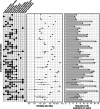Nature and prevalence of combinations of mental disorders and their association with excess mortality in a population-based cohort study
- PMID: 32931098
- PMCID: PMC7491620
- DOI: 10.1002/wps.20802
Nature and prevalence of combinations of mental disorders and their association with excess mortality in a population-based cohort study
Abstract
The nature and prevalence of combinations of mental disorders and their associations with premature mortality have never been reported in a comprehensive way. We describe the most common combinations of mental disorders and estimate excess mortality associated with these combinations. We designed a population-based cohort study including all 7,505,576 persons living in Denmark at some point between January 1, 1995 and December 31, 2016. Information on mental disorders and mortality was obtained from national registers. A total of 546,090 individuals (10.5%) living in Denmark on January 1, 1995 were diagnosed with at least one mental disorder during the 22-year follow-up period. The overall crude rate of diagnosis of mental disorders was 9.28 (95% CI: 9.26-9.30) per 1,000 person-years. The rate of diagnosis of additional mental disorders was 70.01 (95% CI: 69.80-70.26) per 1,000 person-years for individuals with one disorder already diagnosed. At the end of follow-up, two out of five individuals with mental disorders were diagnosed with two or more disorder types. The most prevalent were neurotic/stress-related/somatoform disorders (ICD-10 F40-F48) and mood disorders (ICD-10 F30-F39), which - alone or in combination with other disorders - were present in 64.8% of individuals diagnosed with any mental disorder. Mortality rates were higher for people with mental disorders compared to those without mental disorders. The highest mortality rate ratio was 5.97 (95% CI: 5.52-6.45) for the combination of schizophrenia (ICD-10 F20-F29), neurotic/stress-related/somatoform disorders and substance use disorders (ICD-10 F10-F19). Any combination of mental disorders was associated with a shorter life expectancy compared to the general Danish population, with differences in remaining life expectancy ranging from 5.06 years (95% CI: 5.01-5.11) to 17.46 years (95% CI: 16.86-18.03). The largest excess mortality was observed for combinations that included substance use disorders. This study reports novel estimates related to the "force of comorbidity" and provides new insights into the contribution of substance use disorders to premature mortality in those with comorbid mental disorders.
Keywords: Mental disorders; comorbidity; life expectancy; mood disorders; mortality; neurotic/stress-related/somato-form disorders; schizophrenia; substance use disorders.
© 2020 World Psychiatric Association.
Figures





References
-
- Kessler RC. Lifetime and 12‐month prevalence of DSM‐III‐R psychiatric disorders in the United States. Arch Gen Psychiatry 1994;51:8‐19. - PubMed
-
- Pedersen CB, Mors O, Bertelsen A et al. A comprehensive nationwide study of the incidence rate and lifetime risk for treated mental disorders. JAMA Psychiatry 2014;71:573‐81. - PubMed
LinkOut - more resources
Full Text Sources
Miscellaneous

